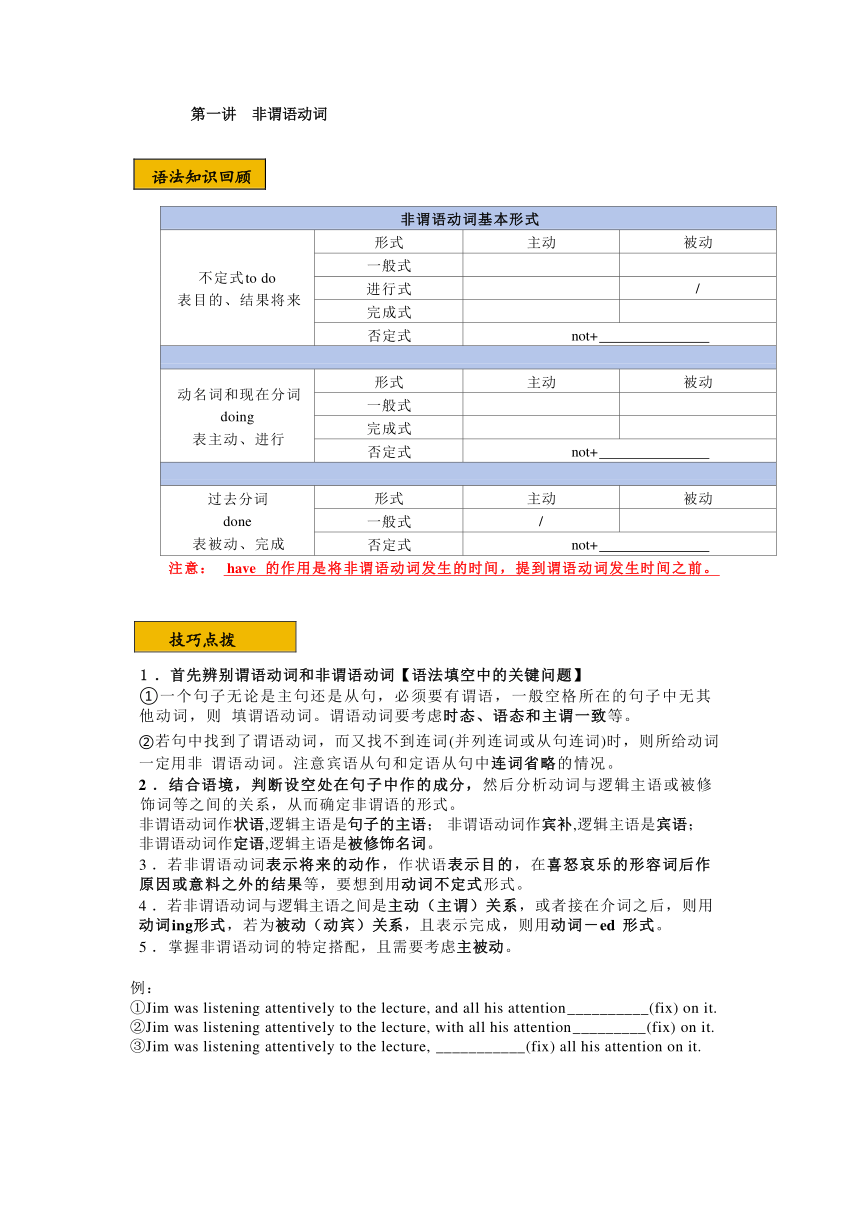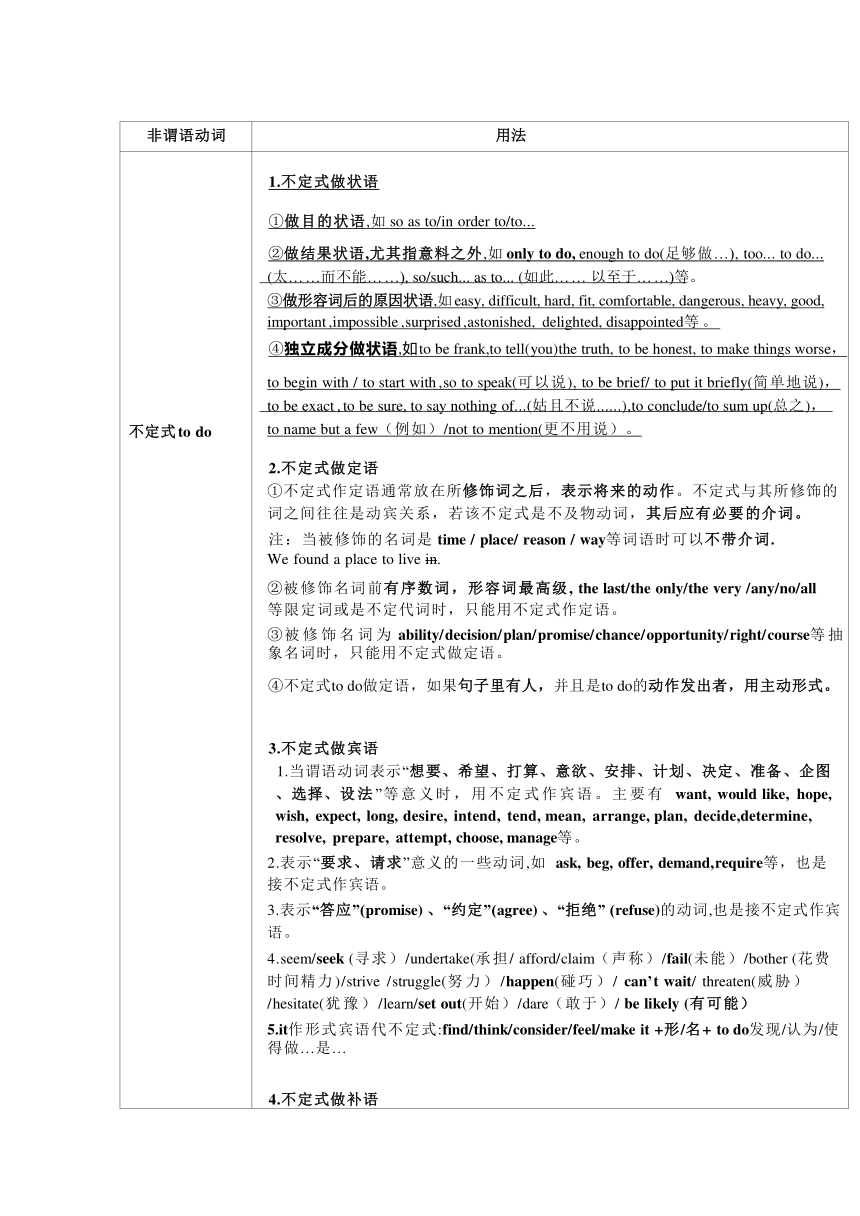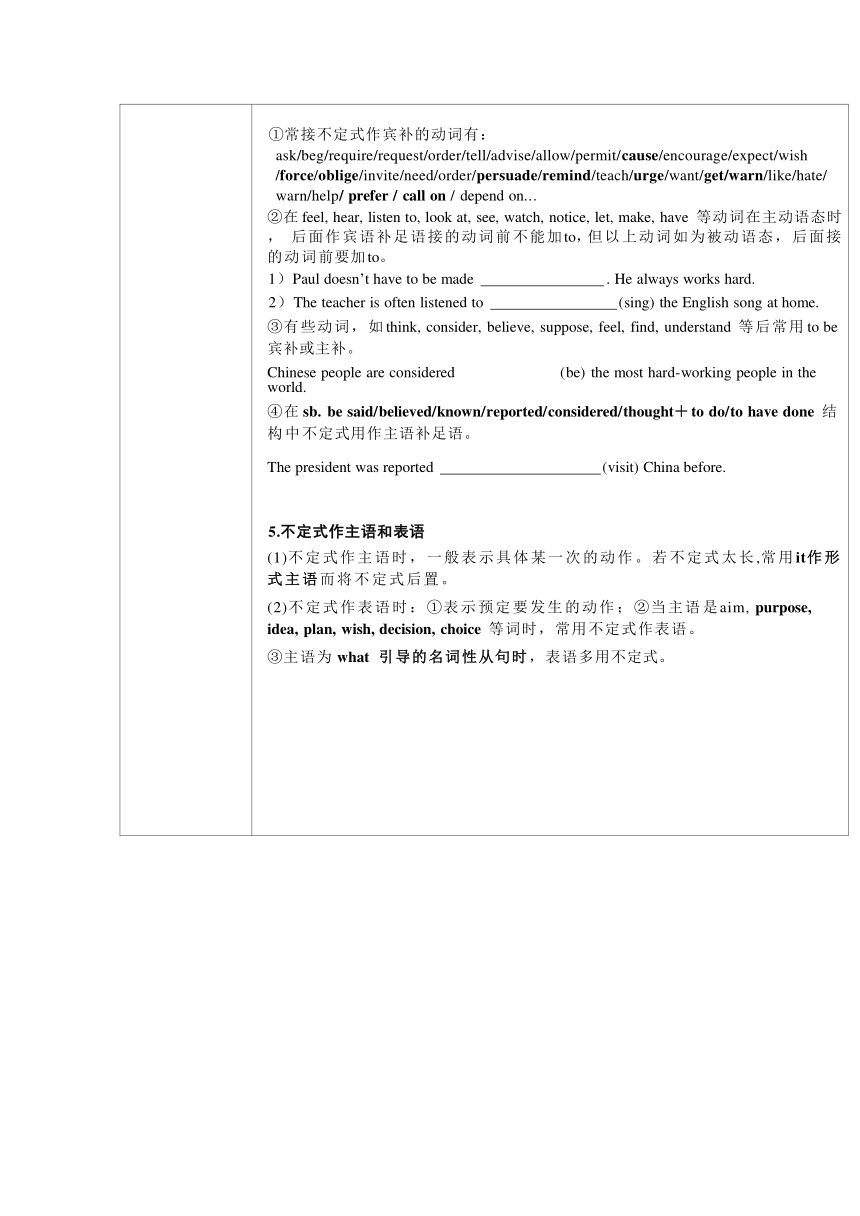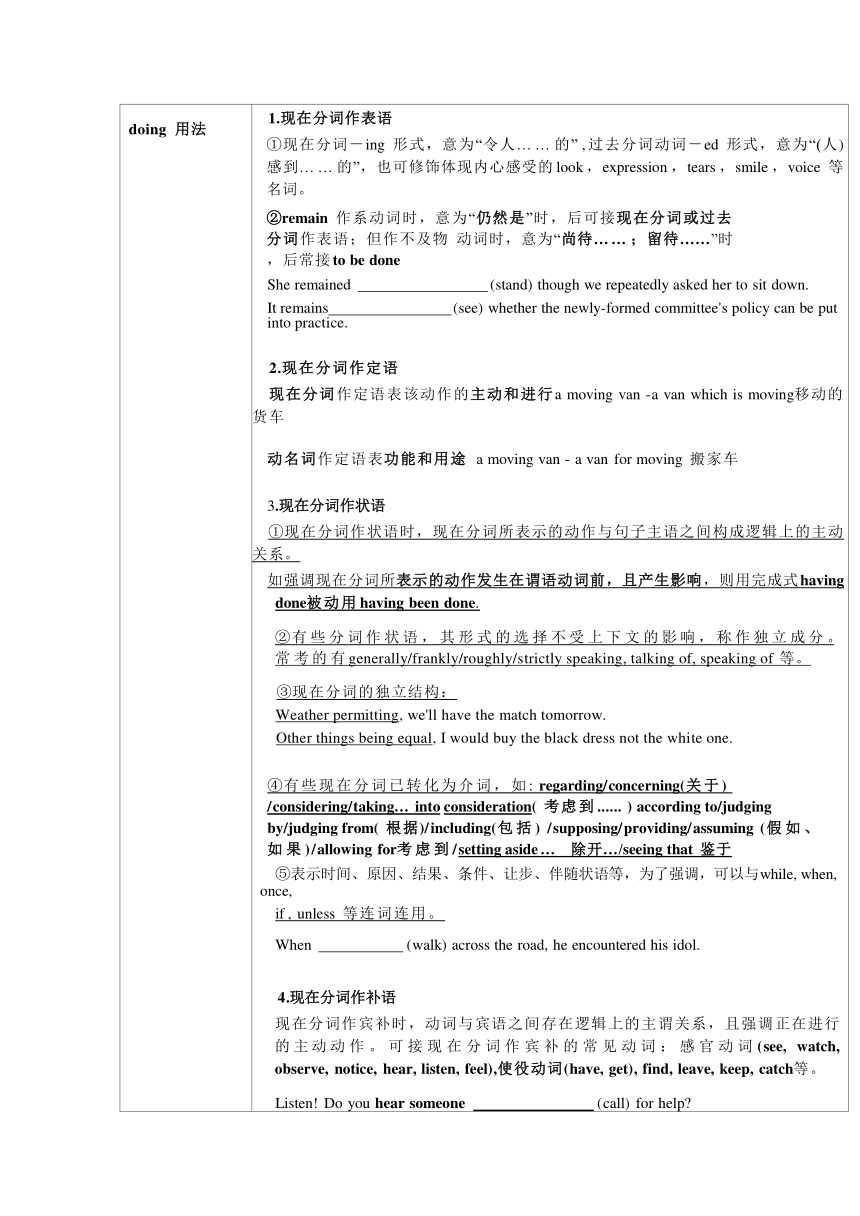2025届高三英语一轮复习:非谓语动词复习讲义学案(无答案)
文档属性
| 名称 | 2025届高三英语一轮复习:非谓语动词复习讲义学案(无答案) |  | |
| 格式 | docx | ||
| 文件大小 | 91.9KB | ||
| 资源类型 | 教案 | ||
| 版本资源 | 人教版(2019) | ||
| 科目 | 英语 | ||
| 更新时间 | 2025-01-03 14:55:07 | ||
图片预览




文档简介
第一讲 非谓语动词
语法知识回顾
非谓语动词基本形式
不定式 to do 表目的、结果将来 形式 主动 被动
一般式
进行式 /
完成式
否定式 not+
动名词和现在分词 doing 表主动、进行 形式 主动 被动
一般式
完成式
否定式 not+
过去分词 done 表被动、完成 形式 主动 被动
一般式 /
否定式 not+
注意: have 的作用是将非谓语动词发生的时间,提到谓语动词发生时间之前。
技巧点拨
1 .首先辨别谓语动词和非谓语动词【语法填空中的关键问题】
①一个句子无论是主句还是从句,必须要有谓语,一般空格所在的句子中无其他动词,则 填谓语动词。谓语动词要考虑时态、语态和主谓一致等。
②若句中找到了谓语动词,而又找不到连词(并列连词或从句连词)时,则所给动词一定用非 谓语动词。注意宾语从句和定语从句中连词省略的情况。
2 .结合语境,判断设空处在句子中作的成分,然后分析动词与逻辑主语或被修饰词等之间的关系,从而确定非谓语的形式。
非谓语动词作状语,逻辑主语是句子的主语; 非谓语动词作宾补,逻辑主语是宾语;
非谓语动词作定语,逻辑主语是被修饰名词。
3 .若非谓语动词表示将来的动作,作状语表示目的,在喜怒哀乐的形容词后作原因或意料之外的结果等,要想到用动词不定式形式。
4 .若非谓语动词与逻辑主语之间是主动(主谓)关系,或者接在介词之后,则用动词ing形式,若为被动(动宾)关系,且表示完成,则用动词-ed 形式。
5 .掌握非谓语动词的特定搭配,且需要考虑主被动。
例:
①Jim was listening attentively to the lecture, and all his attention__________(fix) on it.
②Jim was listening attentively to the lecture, with all his attention_________(fix) on it.
③Jim was listening attentively to the lecture, ___________(fix) all his attention on it.
非谓语动词 用法
不定式 to do 1.不定式做状语 ①做目的状语,如 so as to/in order to/to... ②做结果状语,尤其指意料之外,如 only to do, enough to do(足够做 …), too... to do... (太… …而不能 … …), so/such... as to... (如此 … … 以至于 … …)等。 ③做形容词后的原因状语,如 easy, difficult, hard, fit, comfortable, dangerous, heavy, good, important , impossible , surprised , astonished, delighted, disappointed等。 ④独立成分做状语,如to be frank,to tell(you)the truth, to be honest, to make things worse, to begin with / to start with , so to speak(可以说), to be brief/ to put it briefly(简单地说), to be exact , to be sure, to say nothing of...(姑且不说......),to conclude/to sum up(总之), to name but a few(例如)/not to mention(更不用说)。 2.不定式做定语 ①不定式作定语通常放在所修饰词之后,表示将来的动作。不定式与其所修饰的词之间往往是动宾关系,若该不定式是不及物动词,其后应有必要的介词。 注:当被修饰的名词是 time / place/ reason / way等词语时可以不带介词. We found a place to live in. ②被修饰名词前有序数词,形容词最高级, the last/the only/the very /any/no/all 等限定词或是不定代词时,只能用不定式作定语。 ③被修饰名词为 ability/decision/plan/promise/chance/opportunity/right/course等抽象名词时,只能用不定式做定语。 ④不定式to do做定语,如果句子里有人,并且是to do的动作发出者,用主动形式。 3.不定式做宾语 1.当谓语动词表示“想要、希望、打算、意欲、安排、计划、决定、准备、企图、选择、设法”等意义时,用不定式作宾语。主要有 want, would like, hope, wish, expect, long, desire, intend, tend, mean, arrange, plan, decide,determine, resolve, prepare, attempt, choose, manage等。 2.表示“要求、请求”意义的一些动词,如 ask, beg, offer, demand,require等,也是接不定式作宾语。 3.表示“答应”(promise) 、“约定”(agree) 、“拒绝” (refuse)的动词,也是接不定式作宾语。 4.seem/seek (寻求)/undertake(承担/ afford/claim(声称)/fail(未能)/bother (花费时间精力)/strive /struggle(努力)/happen(碰巧) / can’t wait/ threaten(威胁) /hesitate(犹豫)/learn/set out(开始)/dare(敢于)/ be likely (有可能) 5.it作形式宾语代不定式:find/think/consider/feel/make it +形/名+ to do发现/认为/使得做 …是 … 4.不定式做补语 ①常接不定式作宾补的动词有: ask/beg/require/request/order/tell/advise/allow/permit/cause/encourage/expect/wish /force/oblige/invite/need/order/persuade/remind/teach/urge/want/get/warn/like/hate/ warn/help/ prefer / call on / depend on... ②在 feel, hear, listen to, look at, see, watch, notice, let, make, have 等动词在主动语态时, 后面作宾语补足语接的动词前不能加to,但以上动词如为被动语态,后面接的动词前要加 to。 1)Paul doesn’t have to be made . He always works hard. 2)The teacher is often listened to (sing) the English song at home. ③有些动词,如 think, consider, believe, suppose, feel, find, understand 等后常用 to be宾补或主补。 Chinese people are considered (be) the most hard-working people in the world. ④在 sb. be said/believed/known/reported/considered/thought+to do/to have done 结构中不定式用作主语补足语。 The president was reported (visit) China before. 5.不定式作主语和表语 (1)不定式作主语时,一般表示具体某一次的动作。若不定式太长,常用it作形式主语而将不定式后置。 (2)不定式作表语时:①表示预定要发生的动作;②当主语是aim, purpose, idea, plan, wish, decision, choice 等词时,常用不定式作表语。 ③主语为 what 引导的名词性从句时,表语多用不定式。
doing 用法 1.现在分词作表语 ①现在分词-ing 形式,意为“令人 … … 的” , 过去分词动词-ed 形式,意为“(人)感到 … … 的”,也可修饰体现内心感受的 look ,expression ,tears ,smile ,voice 等名词。 ②remain 作系动词时,意为“仍然是”时,后可接现在分词或过去分词作表语;但作不及物 动词时,意为“尚待… … ;留待……”时,后常接 to be done She remained (stand) though we repeatedly asked her to sit down. It remains (see) whether the newly-formed committee's policy can be put into practice. 2.现在分词作定语 现在分词作定语表该动作的主动和进行 a moving van -a van which is moving移动的货车 动名词作定语表功能和用途 a moving van - a van for moving 搬家车 3.现在分词作状语 ①现在分词作状语时,现在分词所表示的动作与句子主语之间构成逻辑上的主动关系。 如强调现在分词所表示的动作发生在谓语动词前,且产生影响,则用完成式 having done被动用 having been done. ②有些分词作状语 ,其形式的选择不受上下文的影响 ,称作独立成分 。常考的有generally/frankly/roughly/strictly speaking, talking of, speaking of 等。 ③现在分词的独立结构: Weather permitting, we'll have the match tomorrow. Other things being equal, I would buy the black dress not the white one. ④有些现在分词已转化为介词,如: regarding/concerning(关于) /considering/taking... into consideration( 考 虑 到 ...... ) according to/judging by/judging from( 根 据 )/including(包括) /supposing/providing/assuming (假如、如果)/allowing for考虑到/setting aside … 除开 …/seeing that 鉴于 ⑤表示时间、原因、结果、条件、让步、伴随状语等,为了强调,可以与 while, when, once, if , unless 等连词连用。 When (walk) across the road, he encountered his idol. 4.现在分词作补语 现在分词作宾补时,动词与宾语之间存在逻辑上的主谓关系,且强调正在进行的主动动作。可接现在分词作宾补的常见动词:感官动词(see, watch, observe, notice, hear, listen, feel),使役动词(have, get), find, leave, keep, catch等。 Listen! Do you hear someone (call) for help 1.动名词做主语和表语 (1)动名词作主语常表示抽象的、泛指的概念,也可用 it 作形式主语,把作真正主语的动名词短语放在句末。常用于固定句型:It's a waste of time doing...; It's no use/good doing...; It isuseless doing...; There is no point doing... 等。 (2)动名词作表语时相当于名词,用于解释主语的内容,表语和主语常常可以互换位置。 My job is cleaning the house three times a week.=Cleaning the house three times a week is my job. 2.动名词做宾语 考虑建议不禁想(consider, suggest, can’t help/ resist/stand, feel like, fancy, imagine) 完成欣赏值原谅(finish, enjoy, appreciate, be worth, excuse, pardon) 承认推迟不否认(admit, delay, postpone, deny, oppose) 避免错过继续练(avoid, miss, keep, practice) 介意放弃忙困难(mind, give up, quit, be busy, have difficulty/trouble/problem) 禁止逃跑准冒险(forbid, escape, allow, permit, risk) 做介词宾语: look forward to , put off , lead to , give up, set about(开始),object to(反对),feel like(想要), stick to, insist on(坚持), succeed in, be devoted to, be accustomed/used to, prevent/ban/block/stop/keep/prohibit/bar...from...,be equal to (等于), contribute to (有助于),get down to(开始)see to (注意,处理), pay attention to (注意),when it comes to... (当提到...) There is no good/ point/ sense/ harm (in)+ doing sth. have a hard time/ a good time/ fun (+in) + doing sth. spend/ waste time (in) doing sth. 3.动名词做定语 动名词作定语表功能和用途 a moving van - a van for moving 搬家车
过去分词done用法 1.过去分词做表语 ①现在分词-ing 形式,意为“令人 … … 的” , 过去分词动词-ed 形式,意为“(人)感到 … … 的”,也可修饰体现内心感受的 look , expression, tears , smile , voice 等名词。 2.过去分词做定语 ①过去分词作定语只有一个词时,通常放在被修饰的名词前面(但也有例外) ,是一个短语作定语时,就放在被修饰的名词之后。过去分词作定语时,被修饰的名词与过去分词之间是被动关系。 不及物动词作定语只表示完成,不表示被动: a fallen tree/leaf the risen sun/moon a faded rose a retired worker an escaped prisoner a returned student 3.过去分词做状语 ①过去分词作状语时,过去分词所表示的动作与句子主语之间构成逻辑上的被动关系 ②“be+Ved+介词”的词组,在用作非谓语动词做状语时,直接用过去分词形式: Be+情绪类过去分词:be pleased with(对...满意)/ be surprised/astonished at (对...惊讶) /be interested in /be satisfied with / be frightened at (对...恐惧)/ be tired of=be fed up with (厌倦......)/ be burdened with...(对...有负担)/ be determined to...(决心...) 全神贯注于...:be lost in /be absorbed in /be occupied with / be engaged in /be buried in / be concentrated on /be fixed on 装配有...:be dressed in / be equipped / armed /furnished with 与...联结:be combined/connected with/linked to 坐落于:be seated/ located/situated in 致力于:be dedicated/devoted/committed to 挤满了:be crowded /piled/ packed with 习惯于:be/get accustomed/ used to 困在:be trapped / stuck in... be born in (出生于...) / be faced with(面对...)/be based on...(基于) be known as/ for...(作为/因为...而出名)/be rooted in...(植根于...) be compared with (与...相比)/ be hidden+介词(躲在....)/be addicted to(对...上瘾) be covered with...被...覆盖/be experienced in 在...有经验/be involved in...(涉及) be exposed to...(接触到...) 4.过去分词做补语 过去分词作宾补时,动词与宾语之间存在逻辑上的动宾关系,且表示被动动作。可接过去分词作宾补的常见动词:感官动词(see, watch, observe, notice, hear, listen, feel),使役动词(have, make, let, get), find, leave, keep 等。 He tried to make himself (understand). He left me (confuse). 使役动词 have, get 后接非谓语动词作补语的异同点: have sth. done =get sth. done 让别人做某事; have sb./sth. doing 让 …… 一直做某事 get sth./sb. doing 使 … …开始做某事 have sb. do sth.=get sb. to do sth. 让某人做某事。 【重难点提醒】(4)with的复合结构: ①with+宾语+doing 表示主动,说明动作正在发生或经常发生 ②with+宾语+done 表示被动或完成 ③with+宾语+to do 表示将要发生的动作
特殊用法 接不定式与动名词作宾语意义不同的动词: forget to do sth.忘记去做某事 未做 forget doing sth.忘记做过某事 已做 regret to do sth.对即将做的事表示遗憾 未做 regret doing sth.对做过的事表示后悔 已做 remember to do sth.记得去做某事 未做 remember doing sth.记得做过某事 已做 stop to do sth.停下来做某事 stop doing sth.停止做某事 try to do sth.尽力去做某事 try doing sth.尝试做某事 go on to do sth.继续做另一件事 go on doing sth.继续做原来做的事 Imean to do sth.打算做某事 mean doing sth.意味着做某事 Ican't help to do sth.不能帮助做某事 can't help doing sth.情不自禁地做某事 【易错提醒】 (1)动词 want, need, require 作“ 需要”讲时,其后要用 v.-ing形式的主动形式或不定式的被动形式作宾语。与此用法相同的动词还有 deserve(值得)。 (2) 不定式作动词( 短语)learn, decide, know, wonder, show, tell, understand, explain, teach, advise, find out等的宾语时,前面常带引导词 how, what, whether, where, when, who 等。 (3)介词后一般要接 v.-ing 形式作宾语,但介词 but/except后接不定式作宾语时,若前有实义动词 do ,不定式要省略 to。
1.Now the internet keeps us (inform) of what is going on around us at any time.
2.Misunderstanding (arise) from the lack of communication, unless handled properly, may lead to serious problems .
3.A visually-challenged man from Beijing recently hiked 40 days to Xi’an, as a first step (journey) the Belt and Road route by foot.
4.It remains (see) whether or not they will accept the offer.
5. (intend) to enrich students ’ school life, our program features the fun of English.
6.The room (measure) five meters across is comfortable to live in.
7. Mr Wang and his students spend their time restoring clocks (date) back hundreds of years.
I usually have fast food (deliver) to my office when I am busy.
Please read your article in a loud voice to make yourself (hear) clearly by all.
10.The boy (seat) on the sofa is enjoying a film.
11. In addition to the six-sheep chariot, scientists unearthed a four-wheeled wooden chariot, probably drawn by horses, (equip) with a fancy umbrella.
12. (consist) of chewy handmade noodles and flavorful and clear soup, shaved a beef deep red chili oil and lots of characteristic ingredients, Lanzhou Beef Noodles has received a large number of votes from Chinese citizens.
13. Zhai, the commander of the mission, was the first (come) out of the capsule,waving his hand to the cheering crowd on site with a big smile.
14. The celebration, claimed by the organizers (be) the largest Chinese New Year event outside Asia, started at 10 am with a diverse parade ( 游 行) (feature) handcrafted floats, dragon dance troupes (表演团), and displays of traditional Chinese costumes.
15. She was nowhere (see).
16. (expose) too early to the foreign language study, according to some experts, may lead to some unfavorable outcomes.
语法知识回顾
非谓语动词基本形式
不定式 to do 表目的、结果将来 形式 主动 被动
一般式
进行式 /
完成式
否定式 not+
动名词和现在分词 doing 表主动、进行 形式 主动 被动
一般式
完成式
否定式 not+
过去分词 done 表被动、完成 形式 主动 被动
一般式 /
否定式 not+
注意: have 的作用是将非谓语动词发生的时间,提到谓语动词发生时间之前。
技巧点拨
1 .首先辨别谓语动词和非谓语动词【语法填空中的关键问题】
①一个句子无论是主句还是从句,必须要有谓语,一般空格所在的句子中无其他动词,则 填谓语动词。谓语动词要考虑时态、语态和主谓一致等。
②若句中找到了谓语动词,而又找不到连词(并列连词或从句连词)时,则所给动词一定用非 谓语动词。注意宾语从句和定语从句中连词省略的情况。
2 .结合语境,判断设空处在句子中作的成分,然后分析动词与逻辑主语或被修饰词等之间的关系,从而确定非谓语的形式。
非谓语动词作状语,逻辑主语是句子的主语; 非谓语动词作宾补,逻辑主语是宾语;
非谓语动词作定语,逻辑主语是被修饰名词。
3 .若非谓语动词表示将来的动作,作状语表示目的,在喜怒哀乐的形容词后作原因或意料之外的结果等,要想到用动词不定式形式。
4 .若非谓语动词与逻辑主语之间是主动(主谓)关系,或者接在介词之后,则用动词ing形式,若为被动(动宾)关系,且表示完成,则用动词-ed 形式。
5 .掌握非谓语动词的特定搭配,且需要考虑主被动。
例:
①Jim was listening attentively to the lecture, and all his attention__________(fix) on it.
②Jim was listening attentively to the lecture, with all his attention_________(fix) on it.
③Jim was listening attentively to the lecture, ___________(fix) all his attention on it.
非谓语动词 用法
不定式 to do 1.不定式做状语 ①做目的状语,如 so as to/in order to/to... ②做结果状语,尤其指意料之外,如 only to do, enough to do(足够做 …), too... to do... (太… …而不能 … …), so/such... as to... (如此 … … 以至于 … …)等。 ③做形容词后的原因状语,如 easy, difficult, hard, fit, comfortable, dangerous, heavy, good, important , impossible , surprised , astonished, delighted, disappointed等。 ④独立成分做状语,如to be frank,to tell(you)the truth, to be honest, to make things worse, to begin with / to start with , so to speak(可以说), to be brief/ to put it briefly(简单地说), to be exact , to be sure, to say nothing of...(姑且不说......),to conclude/to sum up(总之), to name but a few(例如)/not to mention(更不用说)。 2.不定式做定语 ①不定式作定语通常放在所修饰词之后,表示将来的动作。不定式与其所修饰的词之间往往是动宾关系,若该不定式是不及物动词,其后应有必要的介词。 注:当被修饰的名词是 time / place/ reason / way等词语时可以不带介词. We found a place to live in. ②被修饰名词前有序数词,形容词最高级, the last/the only/the very /any/no/all 等限定词或是不定代词时,只能用不定式作定语。 ③被修饰名词为 ability/decision/plan/promise/chance/opportunity/right/course等抽象名词时,只能用不定式做定语。 ④不定式to do做定语,如果句子里有人,并且是to do的动作发出者,用主动形式。 3.不定式做宾语 1.当谓语动词表示“想要、希望、打算、意欲、安排、计划、决定、准备、企图、选择、设法”等意义时,用不定式作宾语。主要有 want, would like, hope, wish, expect, long, desire, intend, tend, mean, arrange, plan, decide,determine, resolve, prepare, attempt, choose, manage等。 2.表示“要求、请求”意义的一些动词,如 ask, beg, offer, demand,require等,也是接不定式作宾语。 3.表示“答应”(promise) 、“约定”(agree) 、“拒绝” (refuse)的动词,也是接不定式作宾语。 4.seem/seek (寻求)/undertake(承担/ afford/claim(声称)/fail(未能)/bother (花费时间精力)/strive /struggle(努力)/happen(碰巧) / can’t wait/ threaten(威胁) /hesitate(犹豫)/learn/set out(开始)/dare(敢于)/ be likely (有可能) 5.it作形式宾语代不定式:find/think/consider/feel/make it +形/名+ to do发现/认为/使得做 …是 … 4.不定式做补语 ①常接不定式作宾补的动词有: ask/beg/require/request/order/tell/advise/allow/permit/cause/encourage/expect/wish /force/oblige/invite/need/order/persuade/remind/teach/urge/want/get/warn/like/hate/ warn/help/ prefer / call on / depend on... ②在 feel, hear, listen to, look at, see, watch, notice, let, make, have 等动词在主动语态时, 后面作宾语补足语接的动词前不能加to,但以上动词如为被动语态,后面接的动词前要加 to。 1)Paul doesn’t have to be made . He always works hard. 2)The teacher is often listened to (sing) the English song at home. ③有些动词,如 think, consider, believe, suppose, feel, find, understand 等后常用 to be宾补或主补。 Chinese people are considered (be) the most hard-working people in the world. ④在 sb. be said/believed/known/reported/considered/thought+to do/to have done 结构中不定式用作主语补足语。 The president was reported (visit) China before. 5.不定式作主语和表语 (1)不定式作主语时,一般表示具体某一次的动作。若不定式太长,常用it作形式主语而将不定式后置。 (2)不定式作表语时:①表示预定要发生的动作;②当主语是aim, purpose, idea, plan, wish, decision, choice 等词时,常用不定式作表语。 ③主语为 what 引导的名词性从句时,表语多用不定式。
doing 用法 1.现在分词作表语 ①现在分词-ing 形式,意为“令人 … … 的” , 过去分词动词-ed 形式,意为“(人)感到 … … 的”,也可修饰体现内心感受的 look ,expression ,tears ,smile ,voice 等名词。 ②remain 作系动词时,意为“仍然是”时,后可接现在分词或过去分词作表语;但作不及物 动词时,意为“尚待… … ;留待……”时,后常接 to be done She remained (stand) though we repeatedly asked her to sit down. It remains (see) whether the newly-formed committee's policy can be put into practice. 2.现在分词作定语 现在分词作定语表该动作的主动和进行 a moving van -a van which is moving移动的货车 动名词作定语表功能和用途 a moving van - a van for moving 搬家车 3.现在分词作状语 ①现在分词作状语时,现在分词所表示的动作与句子主语之间构成逻辑上的主动关系。 如强调现在分词所表示的动作发生在谓语动词前,且产生影响,则用完成式 having done被动用 having been done. ②有些分词作状语 ,其形式的选择不受上下文的影响 ,称作独立成分 。常考的有generally/frankly/roughly/strictly speaking, talking of, speaking of 等。 ③现在分词的独立结构: Weather permitting, we'll have the match tomorrow. Other things being equal, I would buy the black dress not the white one. ④有些现在分词已转化为介词,如: regarding/concerning(关于) /considering/taking... into consideration( 考 虑 到 ...... ) according to/judging by/judging from( 根 据 )/including(包括) /supposing/providing/assuming (假如、如果)/allowing for考虑到/setting aside … 除开 …/seeing that 鉴于 ⑤表示时间、原因、结果、条件、让步、伴随状语等,为了强调,可以与 while, when, once, if , unless 等连词连用。 When (walk) across the road, he encountered his idol. 4.现在分词作补语 现在分词作宾补时,动词与宾语之间存在逻辑上的主谓关系,且强调正在进行的主动动作。可接现在分词作宾补的常见动词:感官动词(see, watch, observe, notice, hear, listen, feel),使役动词(have, get), find, leave, keep, catch等。 Listen! Do you hear someone (call) for help 1.动名词做主语和表语 (1)动名词作主语常表示抽象的、泛指的概念,也可用 it 作形式主语,把作真正主语的动名词短语放在句末。常用于固定句型:It's a waste of time doing...; It's no use/good doing...; It isuseless doing...; There is no point doing... 等。 (2)动名词作表语时相当于名词,用于解释主语的内容,表语和主语常常可以互换位置。 My job is cleaning the house three times a week.=Cleaning the house three times a week is my job. 2.动名词做宾语 考虑建议不禁想(consider, suggest, can’t help/ resist/stand, feel like, fancy, imagine) 完成欣赏值原谅(finish, enjoy, appreciate, be worth, excuse, pardon) 承认推迟不否认(admit, delay, postpone, deny, oppose) 避免错过继续练(avoid, miss, keep, practice) 介意放弃忙困难(mind, give up, quit, be busy, have difficulty/trouble/problem) 禁止逃跑准冒险(forbid, escape, allow, permit, risk) 做介词宾语: look forward to , put off , lead to , give up, set about(开始),object to(反对),feel like(想要), stick to, insist on(坚持), succeed in, be devoted to, be accustomed/used to, prevent/ban/block/stop/keep/prohibit/bar...from...,be equal to (等于), contribute to (有助于),get down to(开始)see to (注意,处理), pay attention to (注意),when it comes to... (当提到...) There is no good/ point/ sense/ harm (in)+ doing sth. have a hard time/ a good time/ fun (+in) + doing sth. spend/ waste time (in) doing sth. 3.动名词做定语 动名词作定语表功能和用途 a moving van - a van for moving 搬家车
过去分词done用法 1.过去分词做表语 ①现在分词-ing 形式,意为“令人 … … 的” , 过去分词动词-ed 形式,意为“(人)感到 … … 的”,也可修饰体现内心感受的 look , expression, tears , smile , voice 等名词。 2.过去分词做定语 ①过去分词作定语只有一个词时,通常放在被修饰的名词前面(但也有例外) ,是一个短语作定语时,就放在被修饰的名词之后。过去分词作定语时,被修饰的名词与过去分词之间是被动关系。 不及物动词作定语只表示完成,不表示被动: a fallen tree/leaf the risen sun/moon a faded rose a retired worker an escaped prisoner a returned student 3.过去分词做状语 ①过去分词作状语时,过去分词所表示的动作与句子主语之间构成逻辑上的被动关系 ②“be+Ved+介词”的词组,在用作非谓语动词做状语时,直接用过去分词形式: Be+情绪类过去分词:be pleased with(对...满意)/ be surprised/astonished at (对...惊讶) /be interested in /be satisfied with / be frightened at (对...恐惧)/ be tired of=be fed up with (厌倦......)/ be burdened with...(对...有负担)/ be determined to...(决心...) 全神贯注于...:be lost in /be absorbed in /be occupied with / be engaged in /be buried in / be concentrated on /be fixed on 装配有...:be dressed in / be equipped / armed /furnished with 与...联结:be combined/connected with/linked to 坐落于:be seated/ located/situated in 致力于:be dedicated/devoted/committed to 挤满了:be crowded /piled/ packed with 习惯于:be/get accustomed/ used to 困在:be trapped / stuck in... be born in (出生于...) / be faced with(面对...)/be based on...(基于) be known as/ for...(作为/因为...而出名)/be rooted in...(植根于...) be compared with (与...相比)/ be hidden+介词(躲在....)/be addicted to(对...上瘾) be covered with...被...覆盖/be experienced in 在...有经验/be involved in...(涉及) be exposed to...(接触到...) 4.过去分词做补语 过去分词作宾补时,动词与宾语之间存在逻辑上的动宾关系,且表示被动动作。可接过去分词作宾补的常见动词:感官动词(see, watch, observe, notice, hear, listen, feel),使役动词(have, make, let, get), find, leave, keep 等。 He tried to make himself (understand). He left me (confuse). 使役动词 have, get 后接非谓语动词作补语的异同点: have sth. done =get sth. done 让别人做某事; have sb./sth. doing 让 …… 一直做某事 get sth./sb. doing 使 … …开始做某事 have sb. do sth.=get sb. to do sth. 让某人做某事。 【重难点提醒】(4)with的复合结构: ①with+宾语+doing 表示主动,说明动作正在发生或经常发生 ②with+宾语+done 表示被动或完成 ③with+宾语+to do 表示将要发生的动作
特殊用法 接不定式与动名词作宾语意义不同的动词: forget to do sth.忘记去做某事 未做 forget doing sth.忘记做过某事 已做 regret to do sth.对即将做的事表示遗憾 未做 regret doing sth.对做过的事表示后悔 已做 remember to do sth.记得去做某事 未做 remember doing sth.记得做过某事 已做 stop to do sth.停下来做某事 stop doing sth.停止做某事 try to do sth.尽力去做某事 try doing sth.尝试做某事 go on to do sth.继续做另一件事 go on doing sth.继续做原来做的事 Imean to do sth.打算做某事 mean doing sth.意味着做某事 Ican't help to do sth.不能帮助做某事 can't help doing sth.情不自禁地做某事 【易错提醒】 (1)动词 want, need, require 作“ 需要”讲时,其后要用 v.-ing形式的主动形式或不定式的被动形式作宾语。与此用法相同的动词还有 deserve(值得)。 (2) 不定式作动词( 短语)learn, decide, know, wonder, show, tell, understand, explain, teach, advise, find out等的宾语时,前面常带引导词 how, what, whether, where, when, who 等。 (3)介词后一般要接 v.-ing 形式作宾语,但介词 but/except后接不定式作宾语时,若前有实义动词 do ,不定式要省略 to。
1.Now the internet keeps us (inform) of what is going on around us at any time.
2.Misunderstanding (arise) from the lack of communication, unless handled properly, may lead to serious problems .
3.A visually-challenged man from Beijing recently hiked 40 days to Xi’an, as a first step (journey) the Belt and Road route by foot.
4.It remains (see) whether or not they will accept the offer.
5. (intend) to enrich students ’ school life, our program features the fun of English.
6.The room (measure) five meters across is comfortable to live in.
7. Mr Wang and his students spend their time restoring clocks (date) back hundreds of years.
I usually have fast food (deliver) to my office when I am busy.
Please read your article in a loud voice to make yourself (hear) clearly by all.
10.The boy (seat) on the sofa is enjoying a film.
11. In addition to the six-sheep chariot, scientists unearthed a four-wheeled wooden chariot, probably drawn by horses, (equip) with a fancy umbrella.
12. (consist) of chewy handmade noodles and flavorful and clear soup, shaved a beef deep red chili oil and lots of characteristic ingredients, Lanzhou Beef Noodles has received a large number of votes from Chinese citizens.
13. Zhai, the commander of the mission, was the first (come) out of the capsule,waving his hand to the cheering crowd on site with a big smile.
14. The celebration, claimed by the organizers (be) the largest Chinese New Year event outside Asia, started at 10 am with a diverse parade ( 游 行) (feature) handcrafted floats, dragon dance troupes (表演团), and displays of traditional Chinese costumes.
15. She was nowhere (see).
16. (expose) too early to the foreign language study, according to some experts, may lead to some unfavorable outcomes.
